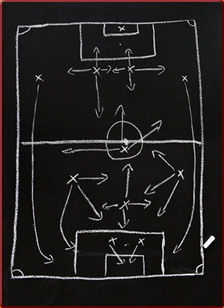How to find the right tactic?
Which tactic is the right one? In soccer, there is no easy answer to this question.
This article will cover which factors a coach should take into account, in order to find the right tactics. This can be completely different from game to game and therefore it is important that the coach is well prepared.
We are working on animations for the different texts, which explain offensive and defensive tactics. We will inform you of the release dates for these via our newsletter, Facebook and Twitter.
A. Team Tactic – The meaning

Team Tactics are made up of actions by players that are coordinated with one another.
This applies to a team’s offensive and defensive moves in equal measure.
To give a basic example, saying “everyone into offence” or “everyone, switch to defense” would already be a team tactic.
These tactics can be improved and made more precise with specific training.
A team’s tactic is defined by planned action, as opposed to chaotic play.
B. Which team tactic is best?
Soccer is so complex that there is no such thing as the “right tactic”. Game tactics are often compared to chess games and this comparison is fairly accurate. The coach has the responsibility of finding the right tactic, and this is dependent on many different factors. Many games are lost due to an incorrect tactical concept. Unfortunately, this is only noticed when the game is over. Sometimes it is never noticed. It doesn’t happen often that a coach takes responsibility for a defeat.
C. Before the game – How do I find the best tactic?
To get my team ready for a tactically sound game, there are certain things I should know and analyze:
1. What is my team capable of?
What are my team’s strengths and weaknesses and what can I expect with regard to tactics? Which players do I have at my disposal?
The tactical plan should cover up weaknesses and expose a team’s strengths.
2. What is our opponent capable of?
Analyze which tactics the opponent prefers, their strengths and weaknesses. It is important to know a lot about the opponent. This includes knowledge about strong and weak positions, starting with the goalkeeper. Are any players injured or banned from playing?
3. Compare the teams?
After questions one and two have been completely analyzed, it is time for what is possibly the most important question: how can I weaken my opponent’s tactics and at the same time, bring my team’s strengths into the game? The trainer’s answer to this question should not just be told to the players during a briefing, but should also be included during training for the game. The positive effect of one-on-one talks should also not be underestimated.
4. Is a glance at the league table enough?
Having a look at the league table is an important part of finding a good tactic, but be careful: a team’s development and their last game results are often more important indicators than the league table, which often says nothing. A team that is high in the table can be going through a weak period or could have only played against weaker teams in the first few games.
5. Where will the game be played?
Is it a home or away game? What are the pitch's conditions like? How big an influence will spectators have? During an away game, teams can often be inhibited, because they are not prepared for the situation. Whether the game will be played on grass, sand or artificial turf also has an effect on tactics.
6. What is at stake?
The necessary tactics greatly depend on the game’s importance. Is it a friendly, championship or cup match? In a friendly match, you can try things out; in a cup match, you want champagne; and in a league match, winning a point can be like a victory. As such, tactics can differ greatly.
7. The referee
The referee can play an important role when it comes to finding the right tactics. What is the situation with off-side decisions? Is the referee lenient?
D. The game is on – correcting game tactics?
During a game, the tactical set-up should be working.
Everything was perfectly clear before the game, but now it’s all different: an important player has been removed from the game, the opposing team doesn’t have the expected line-up, the referee misses every off-side, it’s raining, or your team is losing two to nil.
These things should have been dealt with much earlier. There is nothing worse than stubbornly sticking to a tactic. As coach, you should be as flexible as possible and react in good time. At the same time, you need to be able to gauge what you can demand of your team.
One more thing before I forget: the opponent is sometimes just too strong; no tactic will help you in such situations.